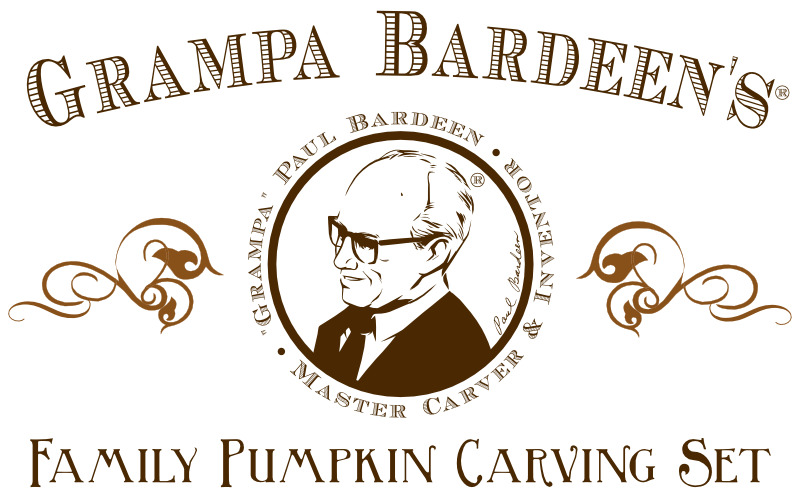A Short History of this Carving Method
Up until the mid-twentieth century, jack-o-lanterns were typically carved with triangle eyes and snaggle-toothed grins using kitchen knives. Around the year 1943, in Racine, Wisconsin, an engineer and jack-of-all-trades put his ingenuity toward the challenge of making pumpkin carving safer for his children. Using pieces of coping-saw blades inserted into wooden dowels, Paul Bardeen (Grampa Bardeen) created the first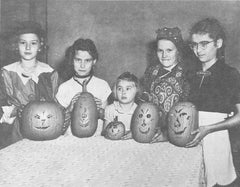 fine-toothed saws designed for carving pumpkins. In addition, Paul developed a method of transferring a pattern onto a pumpkin using the point of a nail to poke along the design lines of a paper pattern pinned to the pumpkin. Once the pattern was removed, one simply carved along the dotted lines. This system enabled the creation of far more artistic and intricate carvings. Growing up, Paul Bardeen’s five children attained some degree of local fame for their unusually intricate and creative jack-o-lanterns, which they would carry door-to-door while trick-or-trea
fine-toothed saws designed for carving pumpkins. In addition, Paul developed a method of transferring a pattern onto a pumpkin using the point of a nail to poke along the design lines of a paper pattern pinned to the pumpkin. Once the pattern was removed, one simply carved along the dotted lines. This system enabled the creation of far more artistic and intricate carvings. Growing up, Paul Bardeen’s five children attained some degree of local fame for their unusually intricate and creative jack-o-lanterns, which they would carry door-to-door while trick-or-trea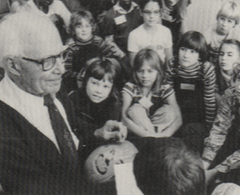 ting in their neighborhood. In 1946, the Racine Journal Times even featured a photo of three of the Bardeen kids, their friends and the jack-o-lantern masterpieces they had created while also featuring a story about Paul Bardeen’s visits to local classrooms to share his new carving method. In 1986, after Paul had passed away, the Bardeen children created the first ever carving kit on the market complete with patterns as a tribute to their father and his unique system.
ting in their neighborhood. In 1946, the Racine Journal Times even featured a photo of three of the Bardeen kids, their friends and the jack-o-lantern masterpieces they had created while also featuring a story about Paul Bardeen’s visits to local classrooms to share his new carving method. In 1986, after Paul had passed away, the Bardeen children created the first ever carving kit on the market complete with patterns as a tribute to their father and his unique system.
Scoop Development: 25 Years
The year after debuting the first pumpkin carving kit in 1985, John decided the kit needed a scoop to facilitate the removal of the goop from inside a pumpkin. He took a long-handled, big-bladed ice cream scoop he had in his kitchen drawer and went to work on it in his basement tool room.
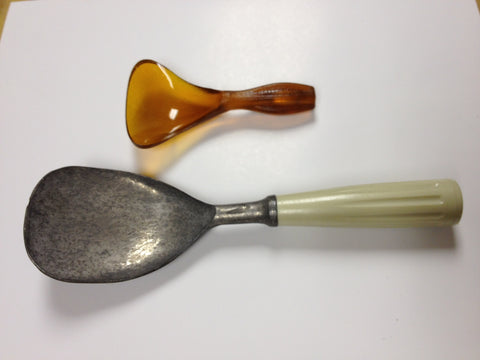
A hacksaw shortened the handle and blade and a bench grinder reshaped the blade into a tool that fit the bill: a scoop that could fit inside a pumpkin with a leading edge that scraped off the goop from the innards and one that was sturdy—no more bending Mom’s spoons! He bought four more ice cream scoops and modified them for his sisters to try that Halloween. The positive feedback led to the creation of the first scoop.
Back then, molds for making plastic parts were made by making a graphite electrode model of the piece and then electrically burning the image into the steel mold. Computers were becoming more instrumental in designing parts and the CAD (computer assisted design) system for producing parts started to be utilized in making molds: design it on the computer and then have the computer tell a steel milling machine to cut out the part.
The plastic injection mold company the Bardeens were using, decided to utilize this system to make the mold for the scoop because they were already doing it to make parts for the space shuttle. When the program was asked to join the handle part of the scoop to the blade part, it crashed! The mold was made by making a graphite copy and then burning it into the steel.
Fast-forward 25 years to a time when parts are routinely created using computer programs with fabulous 3-D capabilities. Designs are sent via the internet to the 3-D copy company, Quickparts, that returns a solid part back in a few days. When we designed the new scoop on the computer, the “modern day” program experienced problems joining the handle to the scoop! Progress?
Tools the Color of Beer!
by John Bardeen

My youngest daughter Kellyn and I worked on developing the set and when it came to deciding on a color for the tools, we had serious discussions. We wanted a color that was classier than the usual Halloween orange and decided on a bronze or amber color. We searched for an amber color we liked in a variety of stores.
While discussing our various samples, I sipped on a beer—when I poured a second, we looked at the color and had the “eureka” experience: the Ruthless Rye IPA from Sierra Nevada was a perfect color! We actually sent a vial of the beer for color matching.
The tools are translucent and have a “sea-glass” texture because the 3-D prototypes were colorless, but translucent and textured. The tools also have imperfections: entrapped air bubbles similar to real amber.
Purer than Ivory Soap

All the components of the Grampa Bardeen Pumpkin Carving Set are made in the USA from CT to OR, except the three 1” x 18 gauge brads (nails) in the pokers—they are made in Taiwan and sold through a US distributor. I have spent hours looking on the internet to find an American manufacturer. Please contact us if you find a US source.
Lubricity?!

The saw blades need to be protected from the acidic pumpkin juice: we chose to coat them with Teflon. Teflon not only protects the steel, but also gives the blades greater lubricity or slipperiness! We feel the extra cost is offset by a better carving experience. The blades are made of spring steel in America by the same manufacturer with the same specifications as the original 1986 carving kit. We know that quality is mandatory in the most critical part of carving an intricate jack-o-lantern--the saws.
Sharing the Bardeen Method at the Pumpkin Patch
by Janice Bardeen Kistler
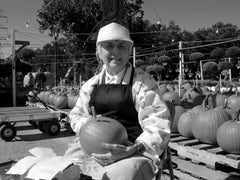 I have not only carved pumpkins for my family and myself yearly for 70+ years, but I also demonstrated the Bardeen method of carving for a local pumpkin stand, Charlie’s Produce, for 25 years. My son, Alexander, now accompanies me and is not only an accomplished carver, but also a talented pattern designer. The owner of the stand, Charlie, loves to celebrate Halloween with pumpkin displays and he stocks a wide range of pumpkins from large to small. He is determined to never run out of pumpkins before the final hours of the 31st. Alex and I set up our chairs in front of a table with our tools ready for action and then turn pumpkins into envied jack-o-lanterns. Spending the day carving and talking with customers about the fun of creating pumpkin masterpieces makes the day very rewarding. We show people how easy it is to saw out the pieces and encourage them to try it.
I have not only carved pumpkins for my family and myself yearly for 70+ years, but I also demonstrated the Bardeen method of carving for a local pumpkin stand, Charlie’s Produce, for 25 years. My son, Alexander, now accompanies me and is not only an accomplished carver, but also a talented pattern designer. The owner of the stand, Charlie, loves to celebrate Halloween with pumpkin displays and he stocks a wide range of pumpkins from large to small. He is determined to never run out of pumpkins before the final hours of the 31st. Alex and I set up our chairs in front of a table with our tools ready for action and then turn pumpkins into envied jack-o-lanterns. Spending the day carving and talking with customers about the fun of creating pumpkin masterpieces makes the day very rewarding. We show people how easy it is to saw out the pieces and encourage them to try it.
